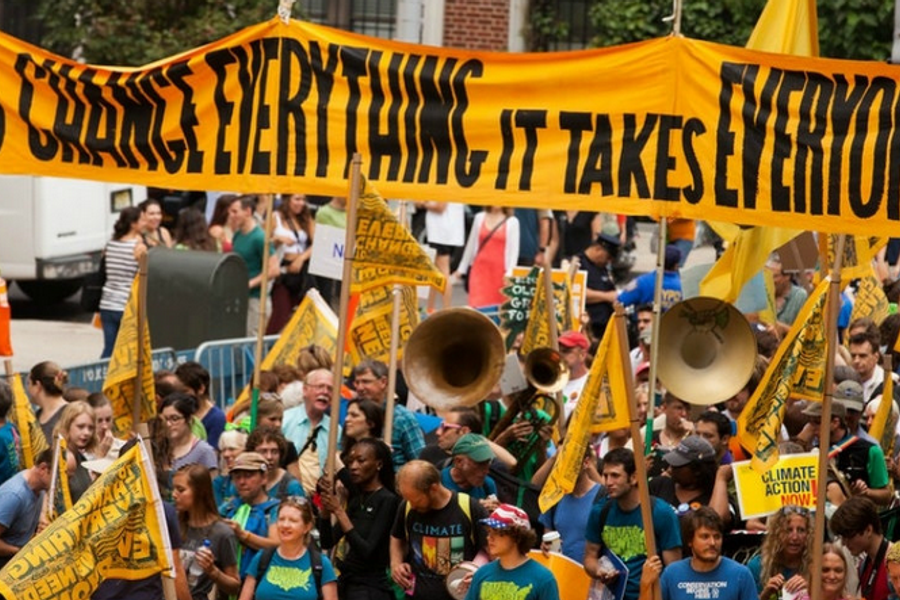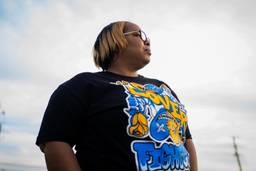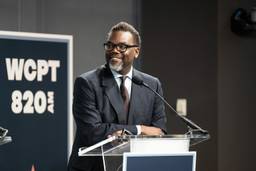The People’s Climate March Is Still Changing the Debate on Climate Change
Much has changed since hundreds of thousands of people marched through New York demanding climate action—and that’s not a coincidence.
Robbie Lieberman

The debate on climate change has changed radically in the past several months, especially since the September 22 People’s Climate March that took place in New York City on the eve of the United Nations Climate Summit.
Voices of anti-fracking activists are taken seriously, the United Nations has inched forward on addressing climate change, as has President Obama. The march alone did not move the conversation along, but its impact was not negligible. While it received surprisingly little attention from corporate media, huge numbers of activists found it profoundly inspiring.
At the very least, the march brought a ray of hope in the face of so much pain and struggle — endless war, police brutality, violence against women and queers, economic inequality, and yes, climate disasters. But that hope, and the overall success of the event, seemed to come as a surprise to many participants, including me. What was noteworthy about the march and what might it tell us about contemporary social movements?
I was a participant and observer in the march, but am also a professor who has taught and written about the culture of U.S. social movements for a number of years. My interest is not only in what brings people together, but in what sustains movements for social change.
Climate change has not been a political focus of mine — I went out of curiosity, to support a cause my partner cared about and to add my voice to those who are concerned about passing on a more just and sustainable world to our children.
Nearly 50 of us traveled from Georgia to New York together on a chartered bus, organized by the Georgia Climate Coalition and the local Sierra Club, to attend the march. In some ways, the journey together turned out to be a microcosm of what the world should look like — people learning from each other, caring about each other’s welfare, sharing hopes, fears, pain and joy, giving each person the space to experience the journey and the march in her or his own way.
There was a group of people from Athens, Georgia, who seemed to know each other, but most of us came from Atlanta and its suburbs and were strangers. Students from my college did not all know each other and none of them were activists.
There was a range of people on the bus that presaged the diversity of the march itself — a mix of ages, colors, class backgrounds and sexual identities, but also experience. Though we were a bit heavy on professors, teachers and college students, we also had a female Roman Catholic Priest, a businessman, a high school student from Alabama, a Vietnam veteran, several (self-defined) grandmothers, a young woman who spent her time making everything she needed from recycled materials and so on.
On the trip to New York, we each got up to introduce ourselves and to say something about why we were going to the march. This was only the beginning of our three-day “teach-in.” The term from the 1960s fits, since so much of what we ended up doing was educating each other in a variety of ways.
The community building that took place was facilitated by our coming from the South. We were proud to be combating the stereotype of how Southerners think. That stereotype was even evident in the organizing of the march; those of us from the so-called “deep South” were instructed to march as a contingent. (As one person put it, this was sort of a “Yankee” way of labeling us.)
The simple experience of meeting each other and being together for a few days gave us all some hope and broke down the sense of isolation one so easily feels in places where we seem to be a small minority. Several historical analogies come to mind, such as the way New Left and counterculture activists came together in the South and lower Midwest to form alternative communities, working together to resist, and ultimately change, the social and political norms of their era.
Another important facet of our experience was that we had strong, and explicitly acknowledged, leadership. Contemporary movements such as Occupy have avoided creating hierarchies and eschewed formal leadership, but this can lead to the “tyranny of structurelessness,” a phrase first used by Jo Freeman in writing about the problems the women’s movement experienced in the 1970s as it sought to challenge existing power relations. Structurelessness, she argued, became a way of masking power and deferring to informal elites.
While contemporary movements have gone a long way toward addressing these problems (as Francesca Polletta and other social movement scholars have discussed), there remains much uncertainty about the meaning of leadership. The resistance to having recognizable leadership was evident at the march, but on the bus we had someone with a name and face who was clearly in charge of sharing knowledge we all needed and facilitating communication.
Not surprisingly, the educators and activists among us returned with renewed commitment to working for social justice. Most moving, however, were the stories of several of the students, who talked about what they would bring back from the march — beginning with the high school student from Alabama, who said he was now determined to educate people in his community about the issue of climate change. And a few of the college students talked about what a life-changing experience this had been.
‘Give Us Bread, But Give Us Roses’
A number of elements distinguished this march from rallies and events that had come before. To begin with, the turnout was far beyond what the organizers (or anyone else) expected; by most accounts there were between 300,000 and 400,000 people. This made the march the largest climate change march ever (at least in the U.S.). It was about twice the size of the 1963 March on Washington and larger than most of the big antiwar protests of any era (with the exception of the 1982 protest against nuclear weapons at the United Nations meeting on disarmament).
The diversity of the crowd was another distinguishing feature. Many people continue to think of environmentalists as hippies or tree-huggers, but the variety of people at this march belied those old stereotypes and illustrated how widespread the concern about climate change is. People from many regions, professions, and movements, and a variety of races, classes, gender identities and degrees of ability joined the action.
The march was also noteworthy for its creativity. The ubiquitous photo of the front of the march shows the celebrity participants, but it does not begin to capture what went on behind them. My companions and I walked along the side of the march, after we could not stand waiting any longer for the enormous crowd to move.
Working our way forward from near the end, we were able to chat with anti-fracking activists from many parts of the country; join with students, accompanied by a small band, as they chanted for justice; observe the irony of people lining up outside the Museum of Natural History while marchers outside it warned about the increasingly rapid extinction of species; admire the carefully choreographed dance of a group of bicyclists; and so on.
Many people who did not participate criticized the march afterwards on the grounds that too many different causes were represented and too many ideas put forward. The easy criticism of other recent movements surfaced again: What do they want? But climate action is not a single-issue movement. The bringing together of many causes in the march was a strength, not a weakness, and it seemed apparent to those of us who participated that the many ideas put forth were all connected.
Though the marchers issued no formal “demands,” it was hard to miss the important shared messages that came through: the urgent need for new climate policies, the fact that the impact of climate change is already being felt, the need to end dependence on fossil fuels and switch to renewable sources of energy.
And just about every contingent at the march, no matter what the particular cause or organization, added to a conversation that needs to take place about how to create a more just and sustainable world. One theme that recurred in many places on the march was an opposition to corporate capitalism and the desire to replace it with a system that puts human need (and the needs of other species) above the search for profit. Whether people came to speak out against fracking, promote alternative and renewable energy, celebrate veganism, oppose war and/or corporate power, promote racial justice and/or labor organizing, we all knew we wanted justice — now.
The march was anything but incoherent (or “a cacophonous mix of messages,” in the words of Cole Stangler). To the contrary, it encouraged and enabled people to see the connections among many different struggles for justice.
‘El pueblo unido, jamas sera vencido’
My partner and I both received comments afterward along the lines of, “Weren’t you just going out in the streets to make yourselves feel good? Isn’t it a waste of money and fossil fuel to bring people together for such an event?” The larger question here is what role such large public protests play in the age of Internet organizing.
The march brought home the message that it is worth our while to communicate with each other face to face. Coming together in large numbers, if only for a few hours, is still a good way to demonstrate our concerns to the powers that be and to show each other we are not carrying on isolated struggles.
The march, as well as the journeys people took to get there, educated those who participated and those who have been paying attention since. It energized people who were already involved and sparked in all of us a desire to do more. The idea of sacrificing now to ensure a better future for your family is generally taken for granted, and the march was a way of applying that principle on a large scale.
But the message that has come through (even, belatedly, in the New York Times) is that we should now see exploring alternative and renewable energy sources as an opportunity rather than a burden:
The day following the march, the Rockefeller Brothers Fund — the wealth of which comes from Standard Oil—divested from fossil fuels. And across the country college students have been pressing their institutions to follow suit.
Meanwhile climate change has returned to the agenda of liberal politicians — as indicated in the progress made at the Lima Climate Change Conference held by the United Nations in Peru in December 2014 and New York Governor Andrew Cuomo’s December 17 announcement of a state ban on fracking. The Pope plans to address the U.N. and issue an encyclical on climate change in 2015.
The march did not lead directly to any of these actions, but surely it helped highlight the broad and growing concern about climate change that makes such actions politically feasible.
Outside the formal political arena, the march highlighted the significance of people coming out of isolation to establish alternative forms of education and develop a collective sense of empowerment in order to challenge entrenched social norms and political institutions.
Lawrence Goodwyn described such a process of movement building in his classic work The Populist Moment. What student of U.S. social movements can forget the image of rural farm families traveling thousands of miles by covered wagon to attend populist encampments, sites where a movement culture was created and sustained? At these encampments, people shared reading material and information, listened to speeches, created a new political language to describe their struggle, and laid plans to create institutions such as agricultural cooperatives as an alternative to corporate domination. These gatherings inspired the development of what Goodwyn called a “collective self-confidence” and instilled hope in hundreds of thousands of people who had lived without it.
Since at least the 1999 anti-globalization protests in Seattle, movements for social justice have become more inclusive and diverse. They have put more emphasis on coalitions, networks, affinity groups — finding new and creative ways for people to affirm their identities while participating in something larger. They have also become much more sensitive about finding and hearing the voice of those on the “front lines,” as the climate march did, highlighting those who are most affected by injustices of all sorts but also realizing that those are often the very people who cannot afford to travel to a summit meeting or a big demonstration. So a march can illustrate how broad the concern is, but the organizing on the issues that takes place before and afterward is vital.
In that organizing, however, we still face difficult questions about leadership, participation and communication. The idealist in me wants to extract lessons from the amazing experience of our bus ride from Georgia and apply them to organizing more generally. We need movements and organizations that illustrate and live the celebration of diversity and community and the search for justice that we seek. We need passion, willingness to share our stories and hear those of others, teaching and learning that crosses bounds of age, race, gender, class and ability, for people to participate (as Students for a Democratic Society put it more than half a century ago in the Port Huron Statement) in the decisions that affect their lives.
Perhaps most of all — like past movements — we need hope, hope and confidence that our combined efforts will make a difference. In the face of climate change, how can we settle for anything less?




